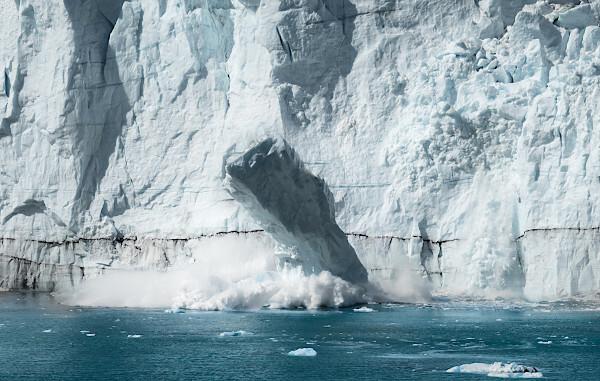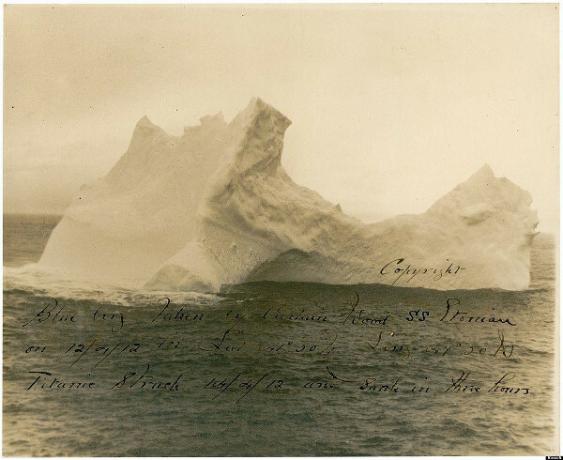iceberg is a large block of ice that floats across the icy oceans of the planet Earth. They are derived from glaciers or ice shelves, being, for this reason, composed of fresh water. A small portion of the iceberg structure is above sea level, while the largest part of its mass is submerged, thus representing a great danger to ships and other vessels.
Read too: What are Earth's oceans?
Topics of this article
- 1 - Summary about iceberg
- 2 - What is an iceberg?
- 3 - How is the iceberg formed?
- 4 - Composition of the iceberg
- 5 - Iceberg and sea level
- 6 - Iceberg and global warming
- 7 - Danger of icebergs
- 8 - What is the biggest iceberg in the world?
summary about iceberg
Icebergs are large blocks of ice that float across the oceans in the coldest regions of planet Earth.
They are blocks of ice that have broken off from glaciers.
Smaller blocks (fragments of icebergs and growlers) may also be derived from other icebergs.
Icebergs are made up of fresh water.
have density smaller than that of sea water and, for this reason, they float in the oceans.
Despite floating, only a small portion of the icebergs is visible, that is, above sea level.
The fact that a large part of the structure of the icebergs is submerged represents a risk of accidents for vessels.
As global warming, the formation of icebergs has taken place more quickly. On the other hand, its melting rate has increased.
The largest iceberg in the world has an area of 4,320 km² and is named A-76.
What is iceberg?
Iceberg is the name given to big blocks floating icem across the oceans, being commonly found in the coldest regions of the planet Earth, such as in the North Atlantic and in the vicinity of the Antarctic continent, to the south. Icebergs have variable shapes and sizes, and may look like a cluster of several pieces of ice, huge planks of flat surface, domes or even mountains.
The word iceberg is spelled in English, and its origin is actually Dutch (ijsberg). It means mountain of ice (ijs = ice; berg = mountain), in allusion to the general form and composition of these large structures.
Although the physical characteristics of icebergs are irregular, the Oceanic Administration and National Atmospheric Agency (NOAA) establishes that they are considered those icebergs structures that present more of 5 meters width It is thickness minimum between 30 and 50 meters, covering an area equal to or greater than 5 km².
Smaller blocks can be classified as shards of ice (or bergy bits) and small icebergs, also known as growlers, which correspond to the smallest types of iceberg, up to 2 meters wide.
Do not stop now... There's more after the publicity ;)
How is the iceberg formed?

Icebergs are formed by a natural process of detachment of ice blocks from glaciers or ice shelves. Breakage or detachment occurs at the edge of glaciers and is usually the result of the evolution of fractures present in the ice.
Smaller structures like the growlers or the fragments of icebergs, can also be formed by larger icebergs by this same process.
Read too:Oceanic ridges — the features of this undersea landform
iceberg composition
Being derived from glaciers, icebergs have the same composition as these icy masses: fresh water. It is important to remember that glaciers and the so-called eternal snow are the largest reservoirs of fresh water in the world, representing approximately 70% of all existing volume on planet Earth.
iceberg and sea level
As we saw earlier, icebergs are made up of fresh water. Water with a lower salt content has a lower density than seawater, which causes icebergs to float across the ocean. The difference is quite small: while the density of ice is approximately 0.917 g/cm³, that of sea water varies between 1.017 g/cm³ and 1.03 g/cm³.
In view of this, we have to About 90% of the iceberg's mass is submerged and only 10% of it is above sea level. In other words, most of the icebergs are not visible, thus making them a risk for vessels.
icebergs and global warming
O global warming has caused significant changes in atmospheric dynamics and in the different climates of planet Earth, which results in diverse effects, such as the increasingly frequent occurrence of extreme events and the acceleration of melting ice of the polar ice caps and glaciers. According to NASA data, the ice melting rate has been 151 billion m³/year in the AntarcticadThe and 273 billion m³/year in Greenland, which corresponds to the volume of water that is incorporated into the oceans.
This picture can be seen in a contradictory way when we think about icebergs. As the melting rate increases, the formation of icebergs has been larger in the last years. However, higher temperatures have caused these huge blocks of ice to melt at the same rate.
Read too: Global warming and species extinction
danger of icebergs
As we learned, icebergs are large frozen bodies that have most of their physical structure submerged. In other words, the visible portion of the icebergs above sea level does not reveal the its submerged magnitude, nor the way in which this mass is distributed under water, which represents a risk by accident for the vessels who sail across the icy oceans.
O most emblematic case how icebergs can be dangerous for ships and boats that travel through the areas where they occur is the one of ship RMS Titanic. Its story is famous and has become the script for numerous cinematographic works and books: the vessel carrying 2223 passengers and crew departed from England towards the American city of New York on April 10, 1912.

Just four days after leaving the English coast, on the night of April 14, 1912, the Titanic collided with an iceberg in the North Atlantic, about 560 km off the coast of Canada. The damage caused by the shock caused the ship to sink, a process that took approximately three hours, with 1500 fatalities.
What is the biggest iceberg in the world?
O The world's largest iceberg is named the A-76 and is located in the Southern Hemisphere, more precisely in the Antarctic continent, south of the Weddell Sea. The A-76 is a huge block of ice that broke off the western portion of the Filchner-Ronne ice shelf in 2021 and has an area of 4,320 km².
A mass of ice is approximately 26 km wide, with a length of 170 km. Since its detachment from the ice shelf, the A-76 has already traveled about 500 km towards the Drake, between the Antarctic continent and southern South America, with almost no change in its dimensions.
By Paloma Guitarrara
Geography Teacher
Discover the story of the sinking of the RMS Titanic and the long history of searches for the wreckage of this ocean liner.
See the main causes of global warming, the consequences and disagreements among the scientific community.
Click here and learn about the polar climate and the characteristics that mark this climate typical of high latitude areas.
Click to understand how the ship floats in the sea. Also check out why the ship doesn't sink, five major shipwrecks in history and other curiosities.
Melting ice, desertification, changes in rainfall, floods and reduced biodiversity are some of the consequences of global warming.
Global warming has caused glaciers to shrink. Check out!
Click here and learn a little more about the poles of Planet Earth.
Access the text and learn about the real story of the RMS Titanic. See the characteristics of this ship and understand how the accident that led to the sinking occurred.


